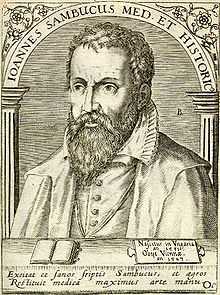Minuscule 124
|
Abbot's facsimile | |
| Name | Caesar-Vindobonensis |
|---|---|
| Text | Gospels |
| Date | 11th-century |
| Script | Greek |
| Found | 1564 |
| Now at | Austrian National Library |
| Size | 21.7 cm by 18.8 cm |
| Type | Caesarean/Byzantine text-type |
| Category | III/V |
| Note | member of f13 |
Minuscule 124 (in the Gregory-Aland numbering), ε 1211 (Von Soden numbering),[1] is a Greek minuscule manuscript of the New Testament, on 188 thick parchment leaves (21.7 by 18.8 cm). Palaeographically it has been assigned to the 11th-century. It has marginalia and liturgical matter. The manuscript is quoted in edition of the Novum Testamentum Graece.
Description
The codex contains the text of the four Gospels with only one lacunae (Luke 23:31-24:28). The text is written in two columns per page, 25-28 lines per page.[2] The initial letters are written in red and blue.[3] It was corrected by the first hand.[4]
The text is divided according to the κεφαλαια (chapters), whose numbers are given at the margin, with their τιτλοι (titles of chapters) at the top of the pages. There is also a division according to the smaller Ammonian Sections with references to the Eusebian Canons (written below Ammonian Section numbers), and the harmony written at the bottom.[3]
It contains the Epistula ad Carpianum, Eusebian Canon tables at the beginning, lists of the κεφαλαια (tables of contents) before each Gospel, liturgical books with hagiographies (synaxaria and Menologion).[3]
According to the colophon, the Gospel of Matthew was written in Hebrew 8 years after the Lord's Ascension, that of Mark was written in Latin 10 years after the Ascension, Luke, in Greek, 15 years after, and John 32 years after.[5]
Text

The text of the Luke 22:43-44 is transferred to follow after Matthew 26:39. The pericope de adulterae (John 7:53-8:11) is not placed in the Fourth Gospel, but after Luke 21:38.[5]
The Greek text of this codex is a representative of the Caesarean text-type. Kurt Aland placed it in Category III.[6] It belongs to the textual family – Ferrar Group. According to the Claremont Profile Method it is a weak member of the Ferrar Family.[7]
The manuscript was considered by Birch as the best of the Vienna codices.[3][4]
History

The manuscript is dated by the INTF to the 11th century.[2]
The manuscript was written in southern Calabria. According to Scrivener "the manuscript was written in Calabria, where it belonged to a certain Leo [i.e. Leo "Hamartolos"], and was brought to Vienna probably in 1564".[4] The person responsible for bringing it to Vienna was Sambucus, the imperial librarian.[3] It once belonged to Zacharias of Taranto.
The manuscript was added to the list of New Testament manuscripts by Griesbach. It was examined by Treschow, Alter, Birch, Ferrar, Abbott, C. R. Gregory (1887), and Kirsopp & Silva Lake. Alter used it in his edition of the Greek text of the New Testament.[8] It was collated by Ferrar. J. Rendel Harris found some affinities with the Old Syriac version.[9]
Currently the codex is located at the Austrian National Library (Theol. Gr. 188) at Vienna.[2]
See also
- List of New Testament minuscules
- Biblical manuscripts
- Family 13
References
- ↑ Gregory, Caspar René (1908). Die griechischen Handschriften des Neuen Testament. Leipzig: J.C. Hinrichs'sche Buchhandlung. p. 52.
- ↑ 2.0 2.1 2.2 K. Aland, M. Welte, B. Köster, K. Junack, Kurzgefasste Liste der griechischen Handschriften des Neues Testaments, Walter de Gruyter, Berlin, New York 1994, p. 54.
- ↑ 3.0 3.1 3.2 3.3 3.4 Gregory, Caspar René (1900). Textkritik des Neuen Testamentes 1. Leipzig: J.C. Hinrichs'sche Buchhandlung. p. 155.
- ↑ 4.0 4.1 4.2 Scrivener, Frederick Henry Ambrose; Edward Miller (1894). A Plain Introduction to the Criticism of the New Testament 1. London: George Bell & Sons. p. 211.
- ↑ 5.0 5.1 Bruce M. Metzger, "Manuscripts of the Greek Bible. An Introduction to Greek Paleography", Oxford University Press, New York - Oxford 1991, p. 120.
- ↑ Aland, Kurt; Aland, Barbara (1995). The Text of the New Testament: An Introduction to the Critical Editions and to the Theory and Practice of Modern Textual Criticism. Erroll F. Rhodes (trans.). Grand Rapids: William B. Eerdmans Publishing Company. p. 129. ISBN 978-0-8028-4098-1.
- ↑ Wisse, Frederik (1982). The Profile Method for the Classification and Evaluation of Manuscript Evidence, as Applied to the Continuous Greek Text of the Gospel of Luke. Grand Rapids: William B. Eerdmans Publishing Company. p. 55. ISBN 0-8028-1918-4.
- ↑ Novum Testamentum Graecum, ad Codicem Vindobonensem Graece expressum: Varietam Lectionis addidit Franciscus Carolus Alter, 2 vols. 8vo, Vienna, 1786-1787.
- ↑ J. Rendel Harris (1893). On the Origin of the Ferrar Group. Cambridge.
Further reading
- W. H. Ferrar, "A Collation of Four Important Manuscripts of the Gospels", ed. T. K. Abbott (Dublin: Macmillan & Co., 1877).
- J. Rendel Harris, "On the Origin of the Ferrar Group" (Cambridge, 1893).
- E. A. Hutton, "Excursus on the Ferrar Group", in "An Atlas of Textual Criticism" (Cambridge, 1911), pp. 49–53.
- Jacob Geerlings, "Singular Variants in 124", S & D XXI, pp. 108–111.
- Kirsopp and Silva Lake, Family 13 (The Ferrar Group). The Text according to Mark (London: Christophers, 1941), pp. 16–18.
- Hutter, Irmgard. Corpus der byzantinischen Miniaturenhandschriften. 5 vols. Stuttgart: Hiersemann, 1977–1997, 5:40-42.
External links
- Minuscule 124 at the Encyclopedia of Textual Criticism
.jpg)